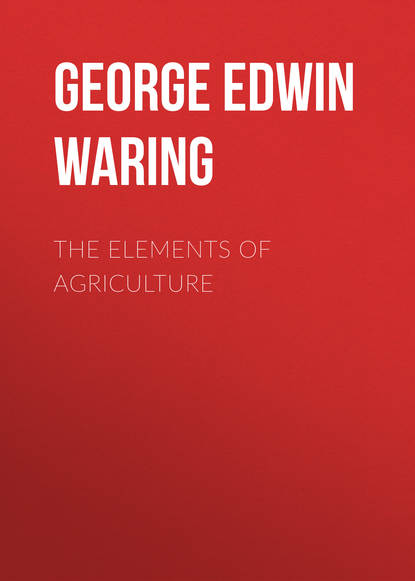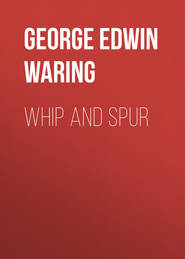По всем вопросам обращайтесь на: info@litportal.ru
(©) 2003-2024.
✖
The Elements of Agriculture
Настройки чтения
Размер шрифта
Высота строк
Поля
A single experiment will suffice to show that night soil may be so kept that there shall be no loss of its valuable gases, and consequently no offensive odor arising from it, while it may be removed and applied to crops without unpleasantness. All that is necessary to effect this wonderful change in night soil, and to turn it from its disagreeable character to one entirely inoffensive, is to mix with it a little charcoal dust, prepared muck, or any other good absorbent—thus making what is called poudrette. The mode of doing this must depend on circumstances. In many cases, it would be expedient to keep a barrel of the absorbent in the privy and throw down a small quantity every day. The effect on the odor of the house would amply repay the trouble.
Should pure night soil be used as a manure?
What precaution is necessary in preparing hog manure for use?
The manure thus made is of the most valuable character, and may be used under any circumstances with a certainty of obtaining a good crop. It should not be used unmixed with some absorbent, as it is of such strength as to kill plants.
For an analysis of human manure, see Section V (#x9_pgepubid00187).
HOG MANURE
Hog Manure is very valuable, but it must be used with care. It is so violent in its action that, when applied in a pure form to crops, it often produces injurious results. It is liable to make cabbages clump-footed, and to induce a disease in turnips called ambury (or fingers and toes). The only precaution necessary is to supply the stye with prepared muck, charcoal-dust, leaf-mould, or any absorbent in plentiful quantities, often adding fresh supplies. The hogs will work this over with the manure; and, when required for use, it will be found an excellent fertilizer. The absorbent will have overcome its injurious tendency, and it may be safely applied to any crop. From the variety and rich character of the food of this animal, his manure is of a superior quality.
Why is the manure from butchers' hog-pens very valuable?
How does the value of poultry manure compare with that of guano?
How may it be protected against loss?
Butchers' hog-pen manure is one of the best fertilizers known. It is made by animals that live almost entirely on blood and other animal refuse, and is very rich in nitrogen and the phosphates. It should be mixed with prepared muck, or its substitute, to prevent the loss of its ammonia, and as a protection against its injurious effect on plants.
POULTRY HOUSE MANURE
Next in value to night soil, among domestic manures, are the excrements of poultry, pigeons, etc. Birds live on the nice bits of creation, seeds, insects, etc., and they discharge their solid and liquid excrements together. Poultry-dung is nearly equal in value to guano (except that it contains more water), and it deserves to be carefully preserved and judiciously used. It is as well worth twenty-five cents per bushel as guano is worth fifty dollars a ton (at which price it is now sold).
Poultry-manure is liable to as much injury from evaporation and leaching as is any other manure, and equal care should be taken (by the same means) to prevent such loss. Good shelter over the roosts, and daily sprinkling with prepared muck or charcoal-dust will be amply repaid by the increased value of the manure, and its better action and greater durability in the soil. The value of this manure should be taken into consideration in calculating the profit of keeping poultry (as indeed with all other stock). It has been observed by a gentleman of much experience, in poultry raising, that the yearly manure of a hundred fowls applied to previously unmanured land would produce extra corn enough to keep them for a year. This is probably a large estimate, but it serves to show that this fertilizer is very valuable, and also that poultry may be kept with great profit, if their excrements are properly secured.
The manure of pigeons has been a favorite fertilizer in some countries for more than 2000 years.
Market gardeners attach much value to rabbit-manure.
SHEEP MANURE
What can you say of the manure of sheep?
The manure of sheep is less valuable than it would be, if so large a quantity of the nitrogen and mineral parts of the food were not employed in the formation of wool. This has a great effect on the richness of the excrements, but they are still a very good fertilizer, and should be protected from loss in the same way as stable manure.
GUANO
Should the use of guano induce us to disregard other manures?
Where and in what manner is the best guano deposited?
Guano as a manure has become world renowned. The worn-out tobacco lands of Virginia, and other fields in many parts of the country, which seemed to have yielded to the effect of an ignorant course of cultivation, and to have sunk to their final repose, have in many cases been revived to the production of excellent crops, and have had their value multiplied many fold by the use of guano. Although an excellent manure, it should not cause us to lose sight of those valuable materials which exist on almost every farm. Every ton of guano imported into the United States is an addition to our national wealth, but every ton of stable-manure, or poultry-dung, or night soil evaporated or carried away in rivers, is equally a deduction from our riches. If the imported manure is to really benefit us, we must not allow it to occasion the neglect and consequent loss of our domestic fertilizers.
The Peruvian guano (which is considered the best) is brought from islands near the coast of Peru. The birds which frequent these islands live almost entirely on fish, and drop their excrements here in a climate where rain is almost unknown, and where, from the dryness of the air, there is but little loss sustained by the manure. It is brought to this country in large quantities, and is an excellent fertilizer, superior even to night soil.
How should it be prepared for use?
It should be mixed with an absorbent before being used, unless it is plowed deeply under the soil, as it contains much ammonia which would be lost from evaporation. It would probably also injure plants. The best way to use guano, is in connection with sulphuric acid and bones, as will be described hereafter.
The composition of the various kinds of guano may be found in the section on analysis.
CHAPTER VII
OTHER ORGANIC MANURES
The number of organic manures is almost countless. The most common of these have been described in the previous chapters on the excrements of animals. The more prominent of the remaining ones will now be considered. As a universal rule, it may be stated that all organic matter (every thing which has had vegetable or animal life) is capable of fertilizing plants.
DEAD ANIMALS
What are the chief fertilizing constituents of dead animals?
What becomes of these when exposed to the atmosphere?
How may this be prevented?
The bodies of animals contain much nitrogen, as well as valuable quantities, the phosphates and other inorganic materials required in the growth of plants. On their decay, the nitrogen is resolved into ammonia,[28 - Under some circumstances, nitric acid is formed, which is equally beneficial to vegetable growth.] and the mineral matters become valuable as food for the inorganic parts of plants.
If the decomposition of animal bodies takes place in exposed situations, and without proper precautions, the ammonia escapes into the atmosphere, and much of the mineral portion is leached out by rains. The use of absorbents, such as charcoal-dust, prepared muck, etc., will entirely prevent evaporation, and will in a great measure serve as a protection against leaching.
If a dead horse be cut in pieces and mixed with ten loads of muck, the whole mass will, in a single season, become a most valuable compost. Small animals, such as dogs, cats, etc., may be with advantage buried by the roots of grape-vines or trees.
BONES
Of what do the bones of animals consist?
What is gelatine?
Describe the fertilizing qualities of fish.
The bones of animals contain phosphate of lime and gelatine. The gelatine is a nitrogenous substance, and produces ammonia on its decomposition. This subject will be spoken of more fully under the head of 'phosphate of lime' in the chapter on mineral manures, as the treatment of bones is more directly with reference to the fertilizing value of their inorganic matter.
FISH
In many localities near the sea-shore large quantities of fish are caught and applied to the soil. These make excellent manure. They contain much nitrogen, which renders them strongly ammoniacal on decomposition. Their bones consist of phosphate and carbonate of lime; and, being naturally soft, they decompose in the soil with great facility, and become available to plants. The scales of fish contain valuable quantities of nitrogen, phosphate of lime, etc., all of which are highly useful.
Refuse fishy matters from markets and from the house are well worth saving. These and fish caught for manure may be made into compost with prepared muck, etc.; and, as they putrefy rapidly, they soon become ready for use. They may be added to the compost of stable manure with great advantage.
Should these be applied as a top dressing to the soil?
What are the fertilizing properties of woollen rags?
What is the best way to use them?
Fish (like all other nitrogenous manures) should never be applied as a top dressing, unless previously mixed with a good absorbent of ammonia, but should when used alone be immediately plowed under to considerable depth, to prevent the evaporation—and consequent loss—of their fertilizing gases.
WOOLLEN RAGS, ETC






